SUNDAY
AUGUST 31 - 2014
Brook
Meadow
Malcolm
Phillips was on Brook Meadow today and captured this
excellent image of a Long-winged Conehead
showing its long antennae and long ovipositor. The
first on the meadow since 2009.
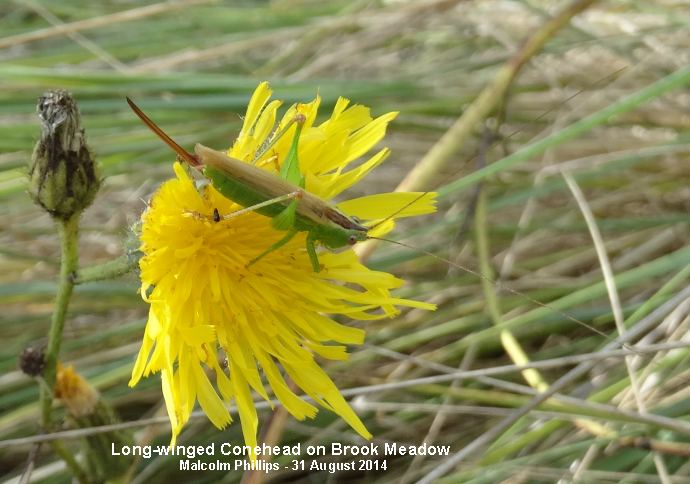
SUNDAY
AUGUST 31 - 2014
Hampshire
Farm
Chris Oakley
was on the Hampshire Farm site today watching three
male Common Darters on one of the French drains. They
appeared to be warming themselves on the pebbles,
wrapping their bodies around each stone rather than
just settling.
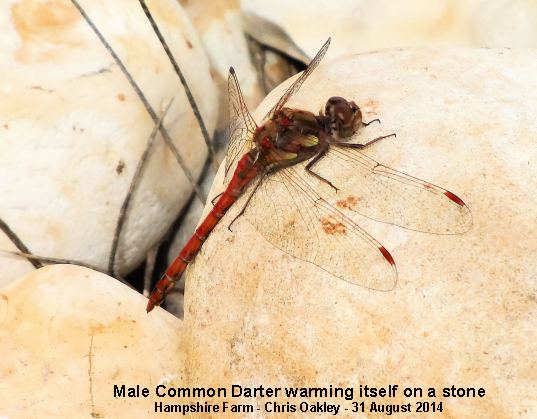
One was apparently
newly emerged as it wasn't fully coloured. As they
only live for two or three weeks I assume they emerge
throughout the summer rather than just the spring.
There was also a Southern Hawker plus several Common
Blue Damselflies. There were 3 Swallows over the pond
plus a good number of House Martins. 30 plus around
the pond and others over the field.
Langstone
Mill Pond
Peter
Milinets-Raby was inspired by Thursday's entry on
Ralph Hollins's web site concerning Little Egrets
flying into roost on Langstone Mill Pond to see what
else comes into roost to Langstone Mill Pond. So, on
Saturday 30th evening, he arrived at Langstone Mill
Pond at 6:55pm (an hour before sunset).
On the low tide mud were: 41 Black-tailed Godwit,
Greenshank (G - R/BRtag -), 2 Grey Plover, 1 Ringed
Plover.
At 7:10pm there were 46 Little Egrets in the
trees with a single Grey Heron. By 7:40pm 16 had flown
in. By sun down (7:55pm) another 34 had flown in.
It was at this point that I became slightly distracted
by the flock of Swallows that was building up
in numbers above my head, at least 400+ (very
impressive). They swirled around calling, then slowly,
but surely, in little groups of 40+ they dived down
into the pond area to roost. No idea where they
actually rested, just dropped into the darkness!
Between 7:55pm and 8:34pm I counted a further 99
Little Egrets flying in to roost, giving me a total of
195 (30+ short of Ralph's count, but with
distractions, gloomy grey cloud cover - so difficult
to pick up an egret in these conditions, I was pleased
with my count).
Two blackbird-sized bats seen over the pond along with
about 5+ Pipistrelle Bats.
Warblington
shore
Peter was out
this morning (Sunday 31st) on the Warblington shore
(6:50am to 9:25am - very low tide). The highlights
were as follows:
16 Yellow Wagtails over this morning all heading south
(highest group was 4), 52 Collared Doves in Castle
Farm.
Ibis field: Blackcap female, Whitethroat, Green
Woodpecker, Male Pheasant, Goldcrest, 2 Sparrowhawk
mobbing a Buzzard.
Conigar Point: 2 Greenshank (G - R/GO - ), 5 Grey
Plover, 12 Dunlin.
Tamarisk Hedge: Great 20 minutes with the hedge alive
with migrants, then 20 minutes later, nothing!
Wheatear on hedge, 12+ Willow Warbler, 4+ Chiffchaff,
3+ Blackcap (2 males, 1+ female), 3+ Sedge
Warbler (see photo) Reed Warbler, Garden
Warbler, 6+ Long-tailed Tits, 2+ Blue Tits, Cetti's
Warbler heard with one quick burst of song.

Pook Lane: 9
Greenshank (RG -/YYtag - and G - R/BBtag - ), 43
Ringed Plover, 91 Dunlin, 4 Knot, 6 Bar-tailed Godwit
(all in washed out summer plumage), 39 Black-tailed
Godwits, 17 Little Egrets feeding together in the
trickle of water in the channel, 2 Common Terns. And
finally circling over the cemetery was a
Hobby.
FRIDAY
AUGUST 29 - 2014
Brook
Meadow
Francis
Kinsella went for a walk on Brook Meadow this
afternoon and got some good photos of dragonflies,
including both male and female Common Darters and this
cracking mature male Southern Hawker.
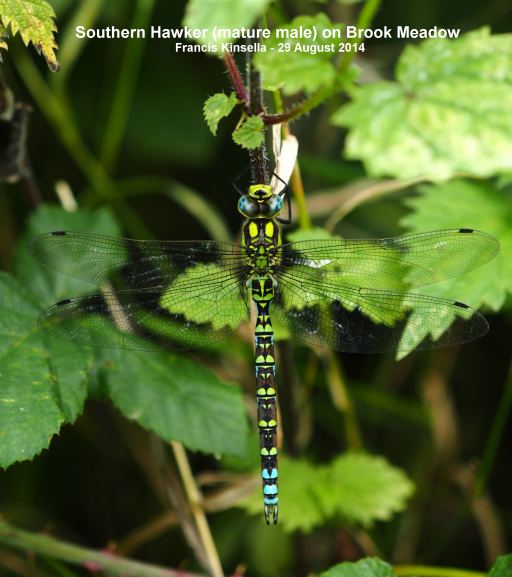
Hampshire
Farm
Chris Oakley
discovered an unusual plant on the Hampshire Farm site
which he thought, at first, looked like Edelweis. He
found it growing in two different places along the
eastern hedge-line. Personally, I had never come
across Edelweis before in Emsworth.
Ralph Hollins came to the rescue, as always. He said
Edelweiss grows above the treeline at an altitude of
1800 to 3000 metres and there is no mention of it
occurring in Britain. He agrees it is not easy to
identify plants from photos but he thinks Chris
Oakley's find is in fact Marsh Cudweed. My only
experience of Marsh Cudweed was on the Railway Wayside
last year.

Regarding the Alsike
Clover that Chris also found on the Hampshire Farm
site (Aug 28), Ralph said it was a good find though he
thinks it is only likely to be found where it has been
sown as a farm crop and does not generally persist
after the crop is harvested.
Farlington
Marshes
Tony and
Hilary Wootton had a windswept walk around Farlington
this p.m. They saw amongst other things, a solitary
Swift struggling to fly south, a good thousand
Starlings, over a hundred Black-tailed Godwits, 2
Common Sandpipers, a Fox and a Small Heath lying at an
even more acute angle than usual.
Black-tailed
Godwit migration
Pete Potts
sent me the following link to a fascinating Dutch web
site showing the seasonal migrations of Black-tailed
Godwits fitted with transmitters. http://volg.keningfanegreide.nl/?lang=en
Most of those shown on the map travel down to West
Africa. The web site is a bit tricky to negotiate, but
I think the godwit to travel furthest so far is called
Nouakchott (colour-ring combination: L3YLLY). It had
reached Moyamba near Freetown in Sierra Leone.
Pete Potts clarified the situation. He said the
godwits featured on the web site that winter in West
Africa are of the nominate Limosa race.
Godwits of the Islandica race which we
see in Emsworth winter down to southern Spain and a
few reach Morocco but they don't go as far as West
Africa. These two races do not interract.
THURSDAY
AUGUST 28 - 2014
Emsworth
Harbour
10:00 at the
marina seawall. Tide rising to high water at 14:00.
Brisk south westerly wind blowing into my face. It did
not look very promising at first, but It turned out to
be quite an interesting session.
Black-tailed Godwits were well down on yesterday; I
counted just 48 with no colour-rings.
There were good numbers of Redshank as usual (50+),
but one of them stood out clearly. It was feeding all
alone and in a very active fashion which reminded me
immediately of Spotted Redshank. Comparing it
with the Common Redshanks, this bird had a paler
plumage, longer legs and bill and a white
fore-supercilium. It was not ringed.
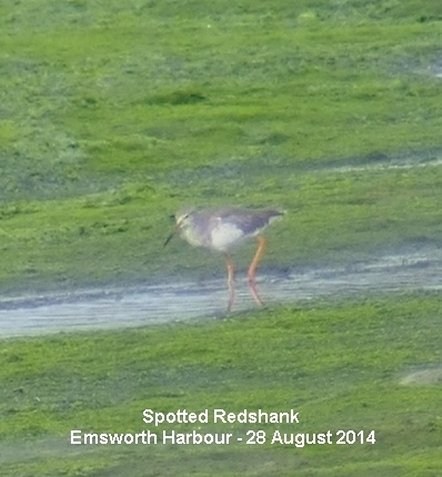
This was my first
Spotted Redshank in Emsworth Harbour this autumn,
though Peter Milinets-Raby has seen some over at
Warblington. This is very likely a bird passing
through on its way south.
Another bird of special interest this morning,
actually feeding quite close to the Spotted Redshank,
was a Common Sandpiper. The last time I
recorded Common Sandpiper in Emsworth Harbour was on
31-Jul-2009.
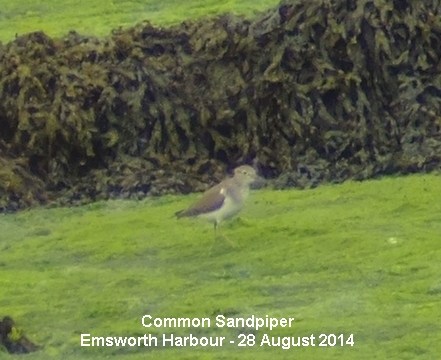
Finally, I also had my
first Grey Plover of the year in Emsworth
Harbour, looking very handsome in its bright summer
plumage. A lone juvenile Shelduck (probably the
same one that I saw yesterday) was swimming in the
channel.

Brook
Meadow
I had a slow
walk through Brook Meadow this afternoon where the
wild flowers were quite glorious. As always at this
time of the year, late summer flowers provide a
wonderful splash of colour, yellow carpets of Common
Fleabane, flecked here and there with pink flowers of
Red Clover, Water Mint and Great Willowherb, while
standing above them all are the tall white umbellifers
of Wild Angelica and Hogweed.
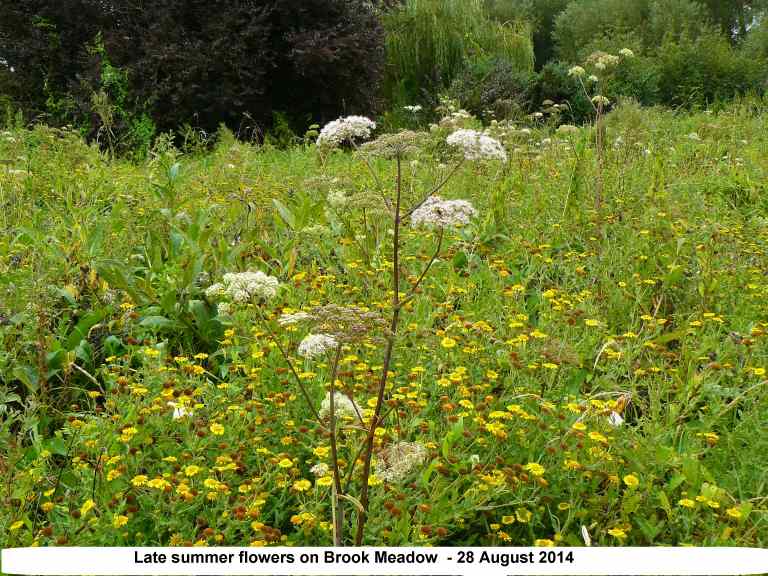
Oak
leaf galls
On a less
happy note, the new Oak saplings on the Seagull Lane
patch have many leaves affected by the white fungus
previously discussed by Ralph Hollins on Aug 26. If
this fungus is Erysiphe alphitoides (as
Ralph suspects) then it could be serious for the tree.
See . . . http://en.wikipedia.org/wiki/Erysiphe_alphitoides

Hampshire
Farm
Chris Oakley
paid particular attention to the water in the pond on
the Hampshire Farm site today. Chris says, "the pond
is very clear and is forming it's own particular
eco-system. There are thousands of tiny water snails
as well as small brown leeches, Water Boatmen and
Pond-skaters. There is an increasing amount of
Water-milfoil and Common Duckweed. The plants I took
to be Yellow Iris now turn out to be Branched
Bur-reed. This grows in abundance in the canal which
is only a couple of hundred yards away. There are
still Red-eyed Damselflies about but I couldn't see
any sign of frogs or newts. I am still astonished that
all these things seem to appear from nowhere. The
House Martins are still there in numbers but there
were only two Swallows.
Chris sent a close up photo of the mystery clover
which he asked me about yesterday. He is now confident
that it is Alsike Clover, which looks pretty good to
me, though it is never easy to identify clovers from
photos.
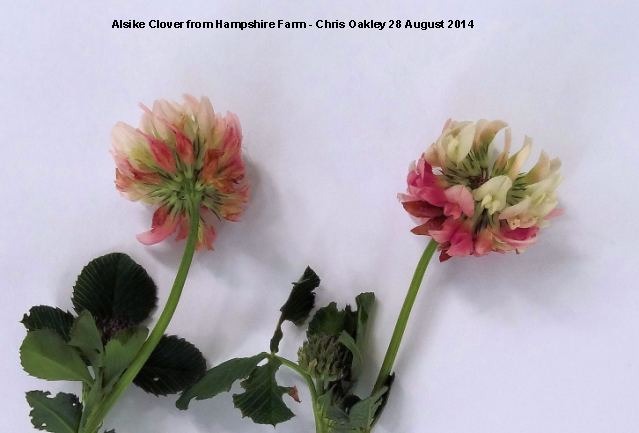
WEDNESDAY
AUGUST 27 - 2014
Emsworth
Harbour
I positioned
myself on the marina seawall at 9:30 - about 4 hours
to high water. The conditions were very good with
light wind and cloudy sun. I counted 95
Black-tailed Godwits feeding on the mudflats - one
better than the count on Aug 18. I went through them
carefully, but could only find one colour-ringed
bird:
L+LL - This bird has been a regular in Emsworth
Harbour for the past 5 winters. First seen here on
06-Nov-09 this was the 42nd record in Emsworth. Photo.
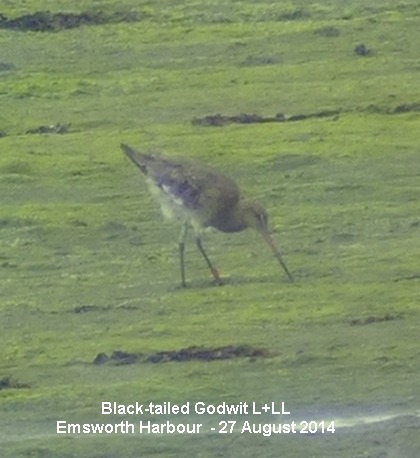
I located three
colour-ringed Greenshank in the harbour, but
there could be more.
RG+BY tag - Ringed 19-Mar-13. 2nd sighting in
Emsworth this autumn.
G+NY tag - Ringed 18-Jan-14. 3rd sighting in
Emsworth. Photo.
G+BN tag - First sighting in Emsworth this
autumn. Photo.
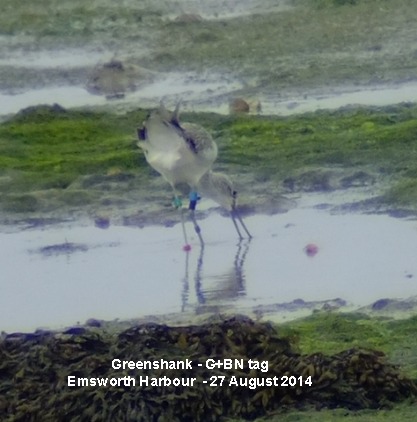
Other birds recorded
in the harbour this morning (apart from gulls): 36
Redshank, 8 Turnstone, 3 Curlew, 5 Little Egrets, 2
Oystercatchers. Mute Swan family with two cygnets -
from Slipper Millpond? One juvenile Shelduck
all alone on the mudflats - my first sighting here
of the year. Photo.
Nutbourne
Bay
I drove over to Farm
Lane by 10:30 to have a look at the bay at Nutbourne
hoping for godwits, Greenshank and possibly Spotted
Redshank, but there was virtually nothing in the
stream apart from a Redshank and Little Egret.
Nore
Barn
Back to Nore
Barn by 11:00. Not much there either apart from the
semi-resident flock of 15 Mute Swans.
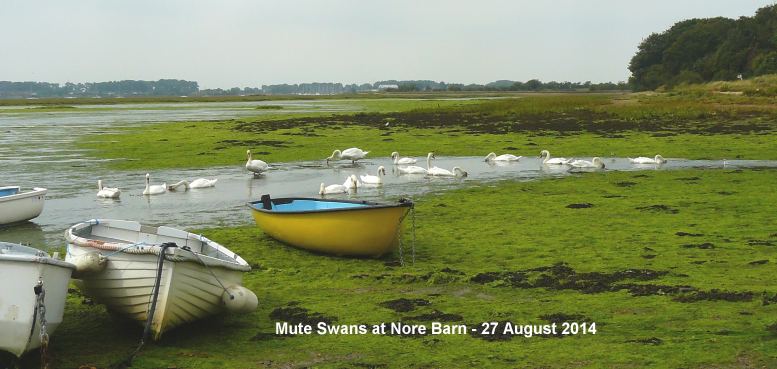
An unringed
Greenshank arrived to feed in the stream; it
looked very much at home and could be the one that
feeds with the Spotted Redshank in the winter months.
Swallows were skimming over the surface of the water.
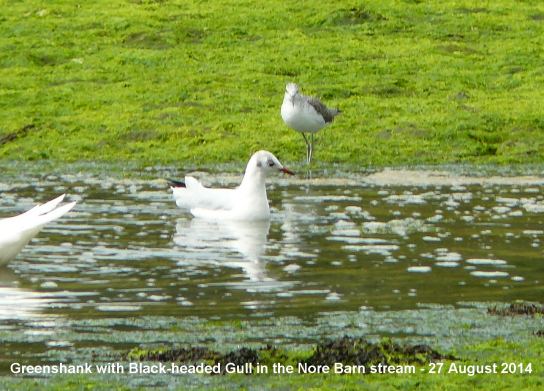
Warblington
shore
Peter
Milinets-Raby (with woolly hat and gloves) went for a
long walk from Warblington to the western edge of Nore
Barn and back along the shore (6:51am to 8:34am - very
low tide).
Ibis Field: Pheasant male, 1+ Blackcap, 1 Chiffchaff,
Green Woodpecker.
And in the Cemetery extension there was a Herring Gull
eating a Wood Pigeon - someone's old kill? (See
photo). After about ten minutes the bird took it away
towards the shore.
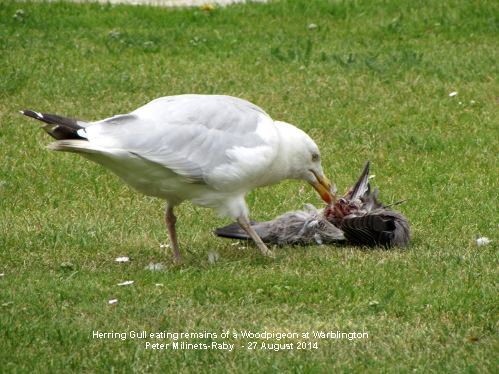
Nore Barn (viewed from
west edge): 2 Stock Doves, 5 Shelduck, 30+ Swallows
hawking over salt marsh.
Conigar Point: 5 Grey Plover, 66 Dunlin, 17 Ringed
Plover, 3 Common Gull, 40+ Swallows hawking low over
the mud and salt marsh with 6+ Sand Martins, 30+
Goldfinch in Tamarisk Hedge, Black-tailed Godwit
juv..
Pook Lane: 9 Greenshank (G - R/BBtag - and G - R/GO -
), 9 Grey Plover, 26 Ringed Plover, 14 Black-tailed
Godwits, 60+ Dunlin, juvenile Shelduck.
Yellow Wagtail heard flying over on two occasions (the
herd of cattle were in the farm and not in the fields
this morning)
TUESDAY
AUGUST 26 - 2014
Kingfisher
Malcolm
Phillips managed his first Kingfisher photo of the
year as the bird perched briefly on the metal rails of
the small footbridge to the north of Peter Pond. Not
one of Malcolm's best, but as he said 'It's a start'.
The lack of any obvious red on the lower mandible
suggests this was a male.

Fungal
growth on Oak leaves
Ralph Hollins
has been looking at the photo (Aug 16) of the white
fungus on the leaves of the Brook Meadow Jubilee Oak
Trees and wonders if the following might provide a id
for it. http://en.wikipedia.org/wiki/Erysiphe_alphitoides
It describes the story of a fungus that was originally
associated with Mangos and Rubber Trees in the tropics
but now attacking Oaks in Britain as a result of
modern world commerce in plants. It is reminiscent of
the story behind Ash Dieback disease and is
worrying.
Comparing the photo of the Oak leaves in the wikipedia
article with the photo I took of the leaves from Brook
Meadow, the two look quite different (though this does
not necessarily mean they are different!). The white
growth on the Brook Meadow leaves is in small patches,
whereas on the wikipedia photo (and other photos I
have looked at on the internet) of the Erysiphe
alphitoides the leaves are smothered with the
white mildew.
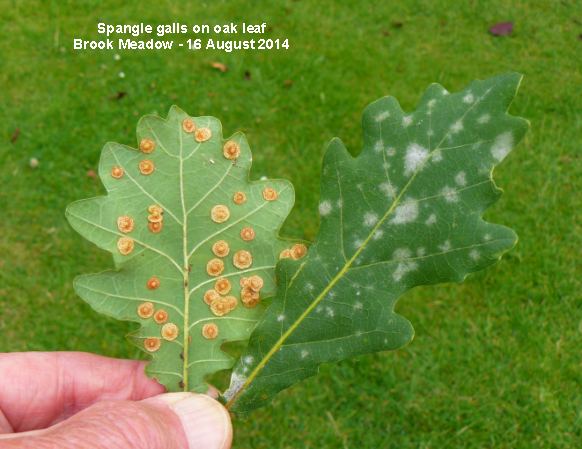
Erysiphe
alphitoides
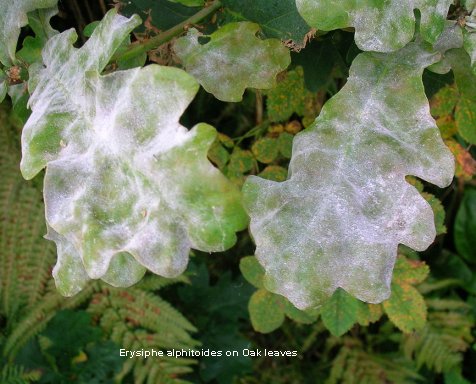
MONDAY
AUGUST 25 - 2014
Greenshank
news
Anne de Potier
provided the following very useful information about
the colour-ringed Greenshanks seen locally this
season.
"Between us we have seen 24 birds, including all but 3
of the ones with geolocators. Our observations include
notable old faithfuls: YG+GY which was first ringed in
2002, the same year as GY+GY, but this bird stays only
for the autumn, and, having its 10th anniversary,
LY+LY. There have also been some first sightings of
birds ringed last September. There is a downloadable
spreadsheet on the website which shows all this
http://www.greenshank.info/migration_story/results.html
I have looked only at roosts, and the differences
between what I see and what those of you looking at
mudflats are interesting. Often the roost which most
birds go to has been too far away to study, so either
the birds are hiding there or roosting elsewhere,
particularly on these smallish tides. I don't think
anyone has yet looked at mudflats east of Thorney,
which contribute birds to the eastern Thorney roost
where I see birds nobody sees on the western side
(including YG+GY and LY+LY). All this reflects what we
found out when we did that radiotracking years
ago.
Good news is that RG+YY, a geolocator bird which we
noticed limping last year, has been seen several times
by Peter and me and seems fine".
Here is a list of the 2014 sightings from the web site
reference: G//R+BB G//R+BL G//R+BN G//R+BR G//R+BY
G//R+GN G//R+GO G//R+GR G//R+GY G//R+RO G//R+RY
G//R+YN GL+YY GN+YY GR+YY LO+YY LY+LY L//R+WY N//R+RY
OO+YY RG+BY RG+YY RW+BY YG+GY
Here
is a digiscoped photo I got of RG+BY and G+BY in
Emsworth Harbour on 13 August 2014

Greenshank
migration
Greenshanks
are familiar migrants throughout Britain and Ireland,
sighted widely along coastal and inland waters in
spring and autumn. Several hundred Greenshanks
over-winter in the UK, mainly in the West and Ireland,
but also here in the Solent region.
Breeding Greenshanks are found in the uplands of north
and west Scotland, using the poorly drained,
boulder-strewn peat soils of the Highlands where the
landscape is more open. 1500 pairs breed in Scotland,
some of which winter in the UK and Ireland.
During passage and whilst over-wintering, Greenshank
use a wide variety of feeding habitats. Inland these
are likely to be lakes, reservoirs and sewage-farms.
On the coast, Greenshanks are mostly found on
estuaries, but also on saltmarsh, lagoons and muddy
shores.
Other Greenshank populations breed throughout much of
Scandinavia and east to Siberia. These birds inhabit
the taiga and forest zones of the Palearctic,
including forest marshes, forest clearings and areas
of scrub with lakes and bogs. Eastern Greenshank
populations winter further south, through sub-Saharan
Africa, southern Asia and even as far as
Australia.
From . . . http://www.greenshank.info/migration_story/migration.html
Hollybank
Woods
Ros Norton
reported on yesterday's walk by the Havant Wildlife
Group
Go to . . . http://familyfellows.com/hwg-walk-reports-2014.htm
SATURDAY
AUGUST 23 - 2014
Emsworth
Harbour
I went over to
the marina seawall at 3pm hoping to catch the
Black-tailed Godwits on a falling tide. However, I
waited for 30 minutes and only 3 turned up. I have
noticed before that later afternoons are not a good
time to catch the godwits. They much prefer the
mornings. I counted 58 Redshank along with a few
Oystercatcher and Curlew. It was great to hear the
bubbling song of the Curlews echoing across the
mudflats.
Malcolm's
news
Yesterday,
Malcolm Phillips was on Brook Meadow and got to see a
Water Vole by the south bridge. This was
sighting number 53 for the year so far.
Not so pleasing was a dead Common Shrew that he
found on the grass path opposite the new tool store.
Shrews are probably quite numerous on Brook Meadow,
but we very rarely see them, except for dead ones.
They are active day and night, but spend about 75% of
their time underground. This one looks in reasonable
condition. I wonder how it died?

Malcolm had two
sightings of a Kingfisher, once at the top end
of Peter Pond and again on a branch across the river
by the north bridge. They must have been different
birds.
Today, Malcolm went out on the solar boat from
Emsworth. He said there was not a lot to see but he
did get to see the Harbour Seals just off
Hayling.
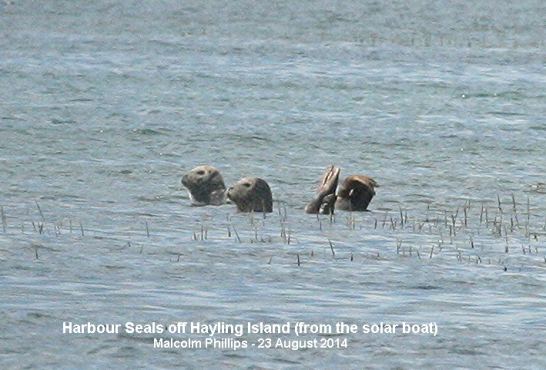
Spotted
Flycatcher
Malcolm's most
exciting sighting yesterday was what looks to me like
a Spotted Flycatcher, though I am happy to be
contradicted. A number of features support this
identification. The faintly streaked crown with a hint
of streaking on the breast. The long tail and wings
with pale fringes on the wing feathers. Most
distinctive are the big dark eye and spiky black bill.
It also has short dark legs.
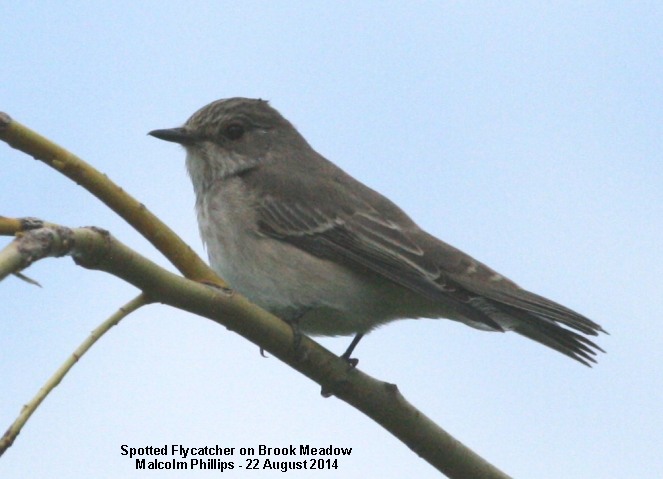
Spotted Flycatcher is
a summer visitor and passage migrant in Hampshire,
nesting mainly in the New Forest. Malcolm's bird is
likely to be a bird moving through through the area
from breeding further north on its way to its winter
grounds in Tropical Africa.
This is only the second Spotted Flycatcher ever to be
seen on Brook Meadow. I got the only other sighting
way back on 29-Sep-2000 when I noted in my diary:
"While waiting by the gasholder for Water Voles which
did not show up, I watched a Spotted Flycatcher
perched prominently on the bushes on the far side of
the river, occasionally making sallies to catch
insects."
Warblington
shore
Peter
Milinets-Raby was out this morning for a walk along
the Warblington shore (6:55am to 9:10am - again
another slow incoming tide). The highlights were as
follows:
Cemetery: 1+ Chiffchaff, 2 Willow Warbler,
Off Conigar Point: Shelduck 1 juvenile, Just 29 Ringed
Plover, 20 Dunlin, 6 Grey Plover, Spotted Redshank
winter - same as yesterday, 2 Mute Swan, 1 juvenile
Black-tailed Godwit, 3 Greenshank.
Tamarisk Hedge: 2+ Willow Warbler, 1 Reed Warbler,
Field by Reed Bed: 8 Yellow Wagtails (a few cows had
been moved into this field, though the wagtails were
very flighty and spent lots of time in the air ,
calling and flying around in circles), 1 Tree
Pipit over south calling, 25+ Goldfinch feeding on
thistle heads. 2 Wheatear (see photo).
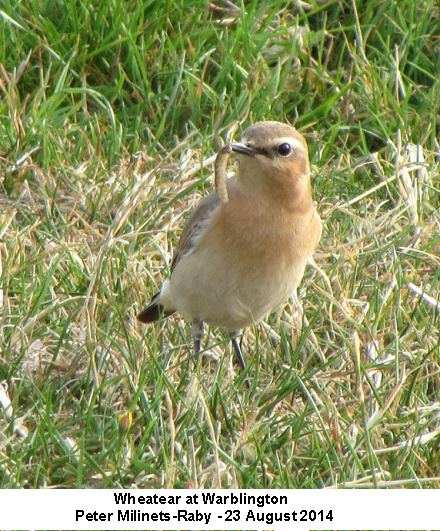
And bird of the
morning (just beating the Tree Pipit) was a
juvenile Whinchat perched along the hedge in
the field.
Off Pook Lane: Another Shelduck (juvenile), 29 Grey
Plover, 17 Knot (2 in summer), 80+ Dunlin, 8
Greenshank (RG - /YY - and G - R/YN - and G - R/BBtag
- ), 3 Ringed Plover, 5 Black-tailed Godwit, 1
Lapwing.
On Langstone Mill Pond: 47 Little Egrets loitering
with intent with 2 Grey Herons.
Inspired by the info on John Goodspeed's web site,
this afternoon I went to compartment 5 on Portsdown
Hill to try and see Autumn Gentian (which I have never
seen before - I have tried several times). I did not
find the masses reported, just the one plant (well I
hope it is one.
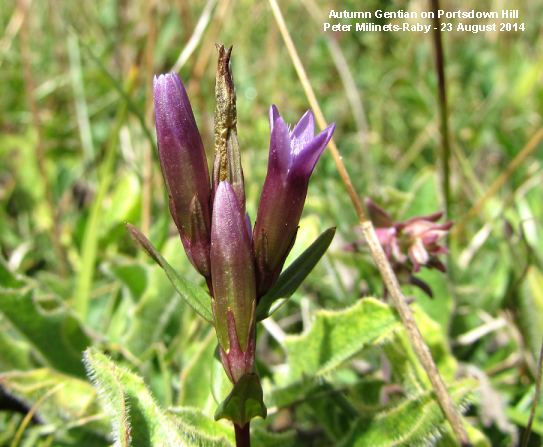
FRIDAY
AUGUST 22 - 2014
Emsworth
Harbour
I went over to
the marina seawall at about 2pm to catch the falling
tide. When I arrived the only birds I could see in the
harbour were Redshank - 86 of them which was
the best count by far this season.
Over the next 30 minutes or so several small flocks of
Black-tailed Godwits drifted onto the mudflats
to feed alongside the Redshank. My final count was 75
godwits.
I went through them several times for colour-rings,
but only found one: LO+RO - This is the 11+
year old bird, ringed in Iceland in 2003 as a breeding
male. It has wandered far and wide since then. Last
seen here on Aug 18 when this photo was taken.
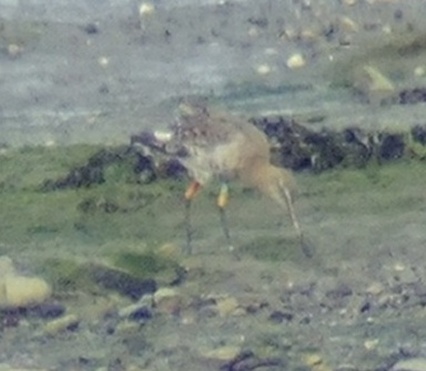
I did not see any
juvenile Black-tailed Godwits, though Peter
Milinets-Raby had one at Warblington this morning, so
they are coming in. Interestingly, we don't get the
variety of waders in Emsworth Harbour that Peter
Milinets-Raby gets a couple of miles up the coast at
Warblington, but the harbour is certainly much
preferred by Black-tailed Godwits.
Warblington
shore
Peter
Milinets-Raby had a wander along the Warblington shore
this morning ahead of a very slow incoming tide
(perfect for waders) 6:42am to 8:51am. The highlights
were:
Off Conigar Point: 70 Ringed Plover (where have
these birds come from and why have they suddenly
appeared? - almost certainly a one off visit to this
bit of shore - lucky to get one on a normal day),
Note
on Ringed Plover Ralph Hollins checked with the
internet and found that some 5,000 pairs breed in
Britain and that the population triples to around
36,000 birds in winter. The extras come from
Greenland/Canada and several sites have noticed mass
arrivals recently (e.g. 172 at Ferrybridge, Weymouth,
on Aug 21). Ralph says the ones Peter saw will be
still on passage and is unlikely to see more than a
dozen on forthcoming visits.
7 Grey Plover, 1
Spotted Redshank (no rings - normal winter plumage, as
compared to the pale bird seen earlier), 1 juvenile
Black-tailed Godwit (very smart looking bird), 48
Dunlin, 2 Mute Swan, 10 Knot (1 in summer).
Off Pook Lane: A further 62 Ringed Plover! 6 Knot (1
in summer), 31 Grey Plover, 9 Greenshank (RG -
/YYtag - and G - R/BRtag and N - R/RO - and G -
R/BBtag and G - R/YN - ). 87 Dunlin, 5 Black-tailed
Godwits, 1 Common Tern, 149+ Redshank, 1 Whimbrel.
The herd of cattle were in the field next to the barn
this morning and in amongst them were 10 Yellow
Wagtails (14 seen on Wednesday when the herd were
down by the shore field) and dashing low amongst the
cattle were an impressive count of 60+
Swallows.
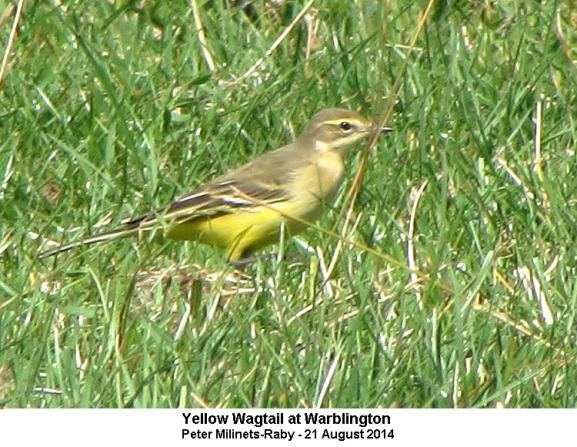
THURSDAY
AUGUST 21 - 2014
Brook
Meadow
I went over to
the meadow this morning for the regular work session.
There was a very big gathering - around 16 volunteers
attended. I just took photos! Main tasks were clearing
the south eastern corner which had grown a layer of
bindweed all over it smothering the grassland, and
clearing part of the Seagull Lane patch. The sand
bag dam in the north-east corner remains a
mystery, but is probably the work of kids. However, it
was decided to leave it as it was doing no harm and
the bags would be safer in the stream than on the
river bank. Here is one of the volunteers tidying up
the dam!
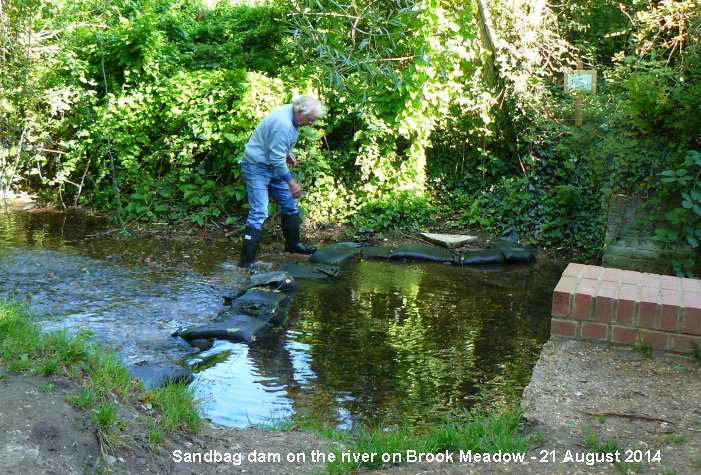
I noticed a more
Common Orache in the south eastern corner with
its distinctive shaped leaves with the lowest lobes
pointing forward arrow-like.
Malcolm Phillips had a
walk around the meadow snapping insects. Among others
he got this rather nice image of a fairly common day
flying moth called Pyrausta aurata. P.
aurata is locally common in England, Wales and
southern Scotland, both larvae and adults occurring in
gardens as well as wild habitats with the foodplants,
ie the mint family. It is sometimes called the 'mint
moth'. It is feeding quite happily on Common Fleabane
in Malcolm's photo.
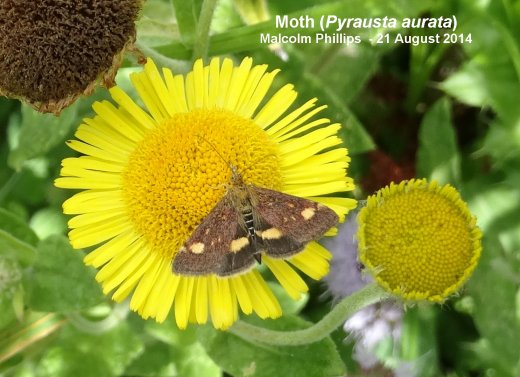
North
Thorney
I had a stroll
around the North Thorney area this afternoon. There
was no sign of the Turtle Dove that Ralph Hollins saw
on the overhead electric cables yesterday. I walked
through the old Marina Farm stables where I did not
see any Swallows. Have they left already? Or maybe
they did not nest?
The dominant plant on the rough ground of the stables
appeared to be Fat Hen with good quantities of
Red Goosefoot mixed in with it. These two
plants are quite different in appearance. Fat Hen is a
tallish, mealy-grey plant with a long grey flower
spike. Red Goosefoot has shiny irregularly toothed
leaves.
I walked a little way down Thorney Road where I had an
excellent view of a Sparrowhawk sweeping across an
open field towards a clump of trees. There was a good
variety of wild flowers on the grass verge, including
Common Toadflax, Common Knapweed, Oxeye Daisy,
Marjoram, Bird's-foot Trefoil, Redshank.
Fox
in garden
Chris Oakley
had another visit from this friendly fox to his garden
this afternoon. It stayed for about ten minutes whilst
Chris kept up 'a steady chat' getting him to turn this
way or that, posing for the camera. Chris will be
leaving food out for him tonight. Maybe, he will bring
his mates round for a party?
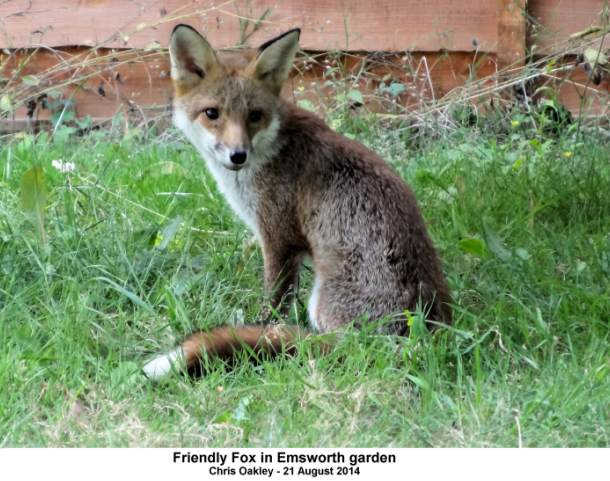
WEDNESDAY
AUGUST 20 - 2014
Nore
Barn
The tide was
very slow to fall this morning - a low neap tide. I
waited from 10-11am and there was still plenty of
water in the harbour. Five Black-tailed Godwits turned
up, but no others. 22 Mute Swans including a family
with 4 cygnets were a surprise. Not sure where the
family was from.
I had a wander around the saltmarshes while I waited
for the water to recede. I was pleased to find both
Common Sea-lavender and Lax-flowered
Sea-lavender on the western side of the stream.
This photo shows the difference in the arrangement of
flowers on these two Sea-lavenders, Lax-flowered on
the right.
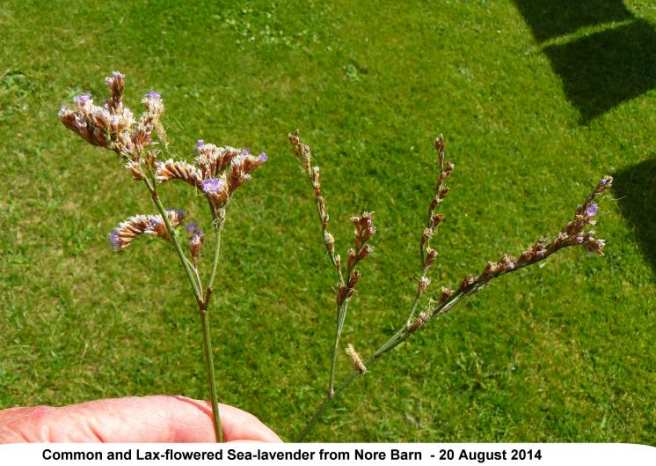
Other plants in flower
included Sea Aster, Golden Samphire, Common
Glasswort, Common Cord-grass (Spartina anglica),
Annual Seablite, Sea Purslane, Sea Plantain, Sea Beet,
Sea Couch, Sea Wormwood. Sea Wormwood is a highly
aromatic grey plant which only grows on the edge of
the saltmarshes east of the picnic table.
Here
is the glasswort
(sometimes called Marsh Samphire by people having it
with fish)
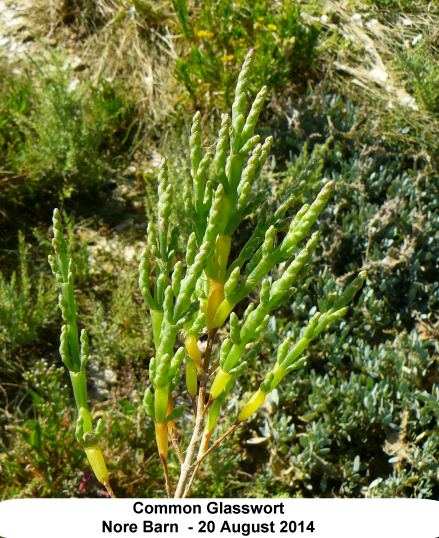
and
Sea Aster
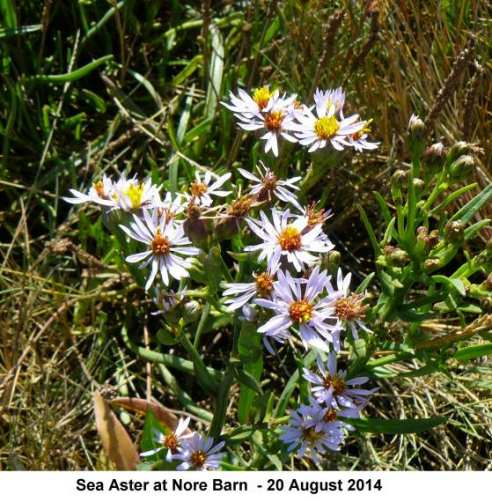
A Red Admiral and a
Hornet were flying on the grassy shore, but I could
not get a photo of either.
Brook
Meadow
I had a slow
walk through the meadow this afternoon. The most
interesting sighting was of several clusters of what I
think were Roe Deer droppings on the grass path
near Beryl's seat on the east side of the north
meadow. The clusters of shiny back pellets and looked
very fresh. I have had no deer sightings reported to
me at all this year from the meadow, though they
certainly do pass through from time to time.
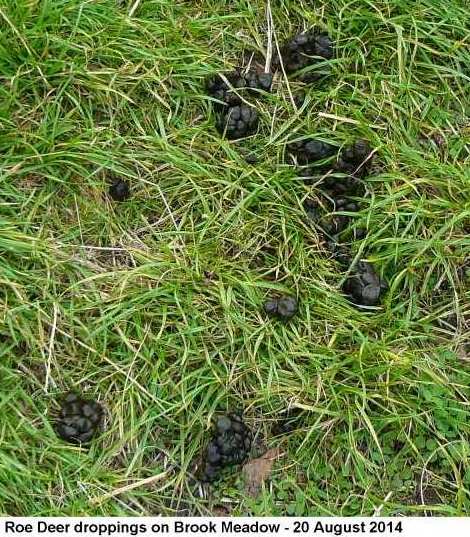
There were lots of
insects feeding on the flower heads of Wild Angelica
as usual. Among them I spotted this striking Long
Horn Beetle (Strangalia maculata). This
beetle is a regular on Brook Meadow at this time of
the year.

The only other
observation of interest was of the appearance of a
line of black sandbags neatly arranged across the
river in the north-east corner creating a small dam in
the river behind the bags. This looks like a
deliberate action by the Environment Agency?
Thorney
Island
Malcolm
Phillips walked down Thorney today and got two
interesting butterfly photos. One was a Small
Heath - a fairly common sight on Thorney, but the
first I have recorded this year.
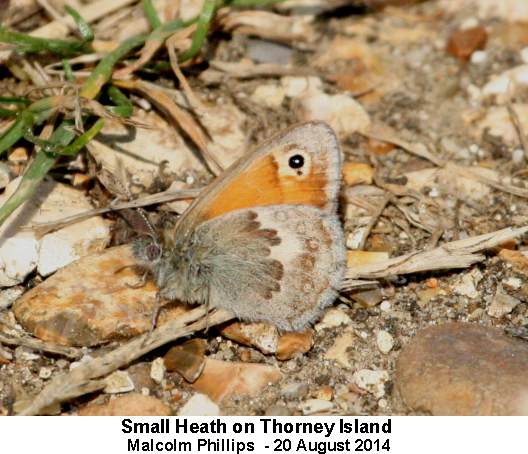
Also, Malcolm captured
this unique image of a Clouded Yellow in full
flight showing its conspicuous back wing tips and
also its curled proboscis. What a shot!

Bee-eater
chicks
Four bee-eater
chicks have fledged on the National Trust's Wydcombe
estate on the Isle of Wight thanks to a joint
protection operation by the National Trust, the RSPB
and Isle of Wight naturalists. It is the first time
the birds, which usually nest in southern Europe, have
bred successfully in the UK for 12 years. Three of the
chicks fledged last week and the fourth has tried out
its wings in the last couple of days. If these
survive, this will be the most successful ever
bee-eater breeding attempt in the UK.
MONDAY
AUGUST 18 - 2014
Emsworth
Harbour
I had an
excited e-mail this morning from Maggie Geggett to say
the Black-tailed Godwits had arrived at Nore Barn. She
counted 41 of them, along with a colour-ringed
Greenshank, 1 Oystercatcher, 2 Redshank and a Lapwing.
I rushed over to Nore Barn by 9.30, but was too late
as the tide was way out and the waders had moved
on.
I guessed they might have gone to the eastern harbour,
so I drove over to the marina seawall where I found a
very good flock of 94 Black-tailed Godwits
feeding together, mostly on the town shore. This is
the largest flock I have seen in Emsworth this season.
Here are just a few of them feeding.
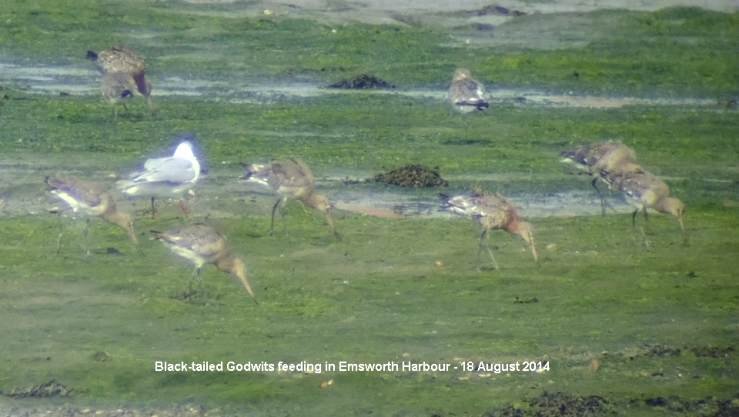
I found three
colour-ringed birds:
G+WR - This is the mega-regular Emsworth godwit
since Sept 2008 with 102 sightings in total! 3rd
sighting this sason.
O+WL - First seen at Nore Barn on 25-Sep-12.
Seen twice last autumn in Emsworth Harbour (east).
This was the first sighting this autumn.
LY+RO - This bird was ringed in Iceland
(Langhús, Fljót) on territory as
breeding male on 11.6.03. I have recorded it a few
times each autumn since then. It is a wandering bird,
having been seen in many other places locally and in
Ireland France and Portugal (per.com Anne de Potier).

There was also one
colour-ringed Greenshank: G+BY geo. Previously
seen in Emsworth Harbour on 13-Aug-14.
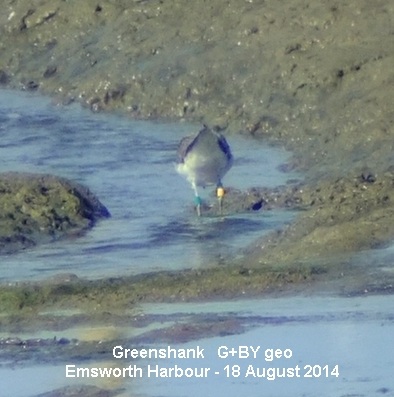
Brook
Meadow
Malcolm
Phillips went round the meadow for an hour this
morning and got photos of several common butterflies,
many of which were looking rather tatty, towards the
end of their season. This one of a female Holly
Blue stood out, showing well the dark tips and
borders on the upper wings which are characteristic of
the second brood of this insect.
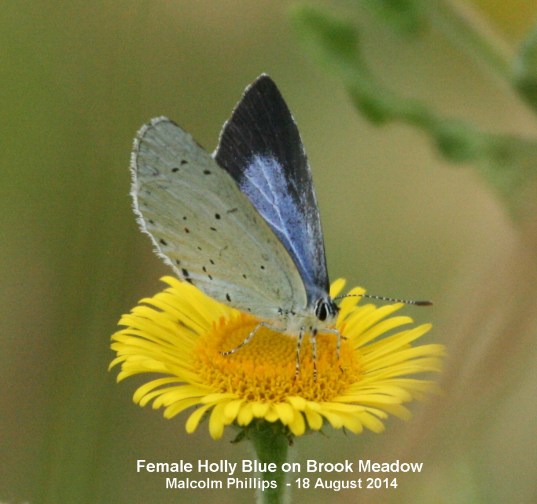
I also liked this
picture of a Honey Bee scrambling around on a
flower head with bulging pollen baskets.
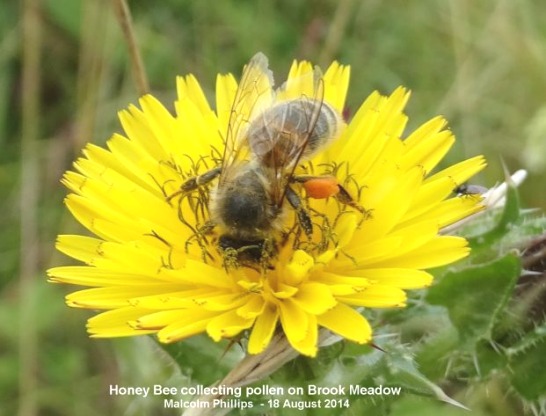
Wax
moth larvae
Regarding the
Wax Moth Larvae that I found in the Bumblebee nest on
Aug 14, Bryan Pinchen says he does not worry too much
about their presence in a nest as they are part and
parcel of the bumblebees life. The bees are usually
successful in rearing new queens and males before the
moths get too rampant.
Bryan has far more of a problem with the number of
nests that are ripped open and destroyed by badgers -
he found 11 such nests on Martin Down recently
resulting in none of those nests having produced next
years queens.
For
earlier observations go to . . Aug
1-16